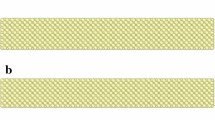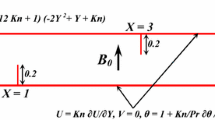Abstract
It is interesting to investigate the number of nanoparticle (NP) and temperature effects on H2O/CuO nanofluid thermal conductivity and the atomic manner in a non-ideal microchannel. The outcomes of the physical features of these structures were supposed using molecular dynamic (MD) method and LAMMPS simulation package. For the study of dynamic properties of nanofluid microchannel system, parameters such as temperature profiles, velocity, density, and potential energy of H2O/CuO atomic structures were calculated. Furthermore, the thermal conductivity of these structures was estimated by the Green–Kubo method in the final step. This simulation shows that nanoparticle number is a crucial parameter in nanofluid movement in a microchannel. Theoretically, via adding CuO nanoparticle to H2O fluid, the maximum rate of velocity, density, temperature, and thermal conductivity of base fluid increases to 0.106 g cm−3, 29.810 A ps−1, 549.217 K, and 0.81 W mK−1 rates, respectively. Moreover, the temperature increase of Cu microchannel increases the rate of density, velocity, temperature, and thermal conductivity of CuO nanofluids.










Similar content being viewed by others
References
Hoseinzadeh S, Heyns PS. Thermo-structural fatigue and lifetime analysis of a heat exchanger as a feedwater heater in power plant. Eng Fail Anal. 2020. https://doi.org/10.1016/j.engfailanal.2020.104548.
Hoseinzadeh S, et al. A detailed experimental airfoil performance investigation using an equipped wind tunnel. Flow Meas Instrum. 2020. https://doi.org/10.1016/j.flowmeasinst.2020.101717.
Hoseinzadeh S, et al. Numerical validation heat transfer of rectangular cross-section porous fins. J Thermophys Heat Transf. 2019;33(3):698–704. https://doi.org/10.2514/1.T5583.
Hoseinzadeh S, et al. The injection of Ag nanoparticles on surface of WO 3 thin film: enhanced electrochromic coloration efficiency and switching response. J Mater Sci Mater Electron. 2017;28(19):14855–63. https://doi.org/10.1007/s10854-017-7357-9.
Ghalambaz M, et al. Melting of nanoparticles-enhanced phase-change materials in an enclosure: effect of hybrid nanoparticles. Int J Mech Sci. 2017;134:85–97. https://doi.org/10.1016/j.ijmecsci.2017.09.045.
Ghalambaz M, et al. Fluid-structure interaction study of natural convection heat transfer over a flexible oscillating fin in a square cavity. Int J Therm Sci. 2017;111:256–73. https://doi.org/10.1016/j.ijthermalsci.2016.09.001.
Ghalambaz M, et al. Phase-change heat transfer in a cavity heated from below: the effect of utilizing single or hybrid nanoparticles as additives. J Taiwan Inst Chem Eng. 2017;72:104–15. https://doi.org/10.1016/j.jtice.2017.01.010.
Ghalambaz M, et al. Effects of nanoparticles diameter and concentration on natural convection of the Al2O3–water nanofluids considering variable thermal conductivity around a vertical cone in porous media. Adv Powder Technol. 2015;26(1):224–35. https://doi.org/10.1016/j.apt.2014.10.001.
Ghasemi MH, et al. Numerical analysis of non-fourier heat transfer in a solid cylinder with dual-phase-lag phenomenon. CMES Comput Model Eng Sci. 2020. https://doi.org/10.32604/cmes.2020.07827.
Bahrami A, et al. Experimental investigation of co-flow jet’s airfoil flow control by hot wire anemometer. Rev Sci Instrum. 2019;90(12):125107. https://doi.org/10.1063/1.5113592.
Sohani A, et al. Determination of Hildebrand solubility parameter of pure 1-alkanols up to high pressures. J Mol Liq. 2020;297:111847. https://doi.org/10.1016/j.molliq.2019.111847.
Goodarzi M, et al. Investigation of nanofluid mixed convection in a shallow cavity using a two-phase mixture model. Int J Therm Sci. 2014;75:204–20. https://doi.org/10.1016/j.ijthermalsci.2013.08.003.
Taylor R, et al. Small particles, big impacts: a review of the diverse applications of nanofluids. J Appl Phys. 2013;113(1):1. https://doi.org/10.1063/1.4754271.
Buongiorno J. Convective transport in nanofluids. J Heat Transfer. 2006;128:240–50. https://doi.org/10.1115/1.2150834.
Argonne Transportation Technology R&D Center.
Minkowycz WJ, et al. Nanoparticle heat transfer and fluid flow, vol. 4. Boca Raton: CRC Press; 2012.
Das SK, Choi SUS, Wenhua Y, Pradeep T. Nanofluids: science and technology. Hoboken: Wiley; 2007. p. 397.
Kakaç S, Pramuanjaroenkij A. Review of convective heat transfer enhancement with nanofluids. Int J Heat Mass Transf. 2009;52(13-14):3187–96. https://doi.org/10.1016/j.ijheatmasstransfer.2009.02.006.
Witharana S, Ding Y. Stability of nanofluids in quiescent and shear flow fields. Nanoscale Res Lett. 2011;6:231.
Chen H, et al. Predicting thermal conductivity of liquid suspensions of nanoparticles (nanofluids) based on rheology. Particuology. 2009;7(2):151–7. https://doi.org/10.1016/j.partic.2009.01.005.
Bahiraei M. Effect of particle migration on flow and heat transfer characteristics of magnetic nanoparticle suspensions. J Mol Liq. 2015;209:531–8. https://doi.org/10.1016/j.molliq.2015.06.030.
Malvandi A, et al. Thermal performance analysis of hydromagnetic Al2O3-water nanofluid flows inside a concentric microannulus considering nanoparticle migration and asymmetric heating. Int J Therm Sci. 2016;109:10–22. https://doi.org/10.1016/j.ijthermalsci.2016.05.023.
Bahiraei M. Studying nanoparticle distribution in nanofluids considering the effective factors on particle migration and determination of phenomenological constants by Eulerian-Lagrangian simulation. Adv Powder Technol. 2015;26(3):802–10. https://doi.org/10.1016/j.apt.2015.02.005.
Pakravan HA, Yaghoubi M. Analysis of nanoparticles migration on natural convective heat transfer of nanofluids. Int J Therm Sci. 2013;68:79–93. https://doi.org/10.1016/j.ijthermalsci.2012.12.012.
Malvandi A, et al. Two-component heterogeneous mixed convection of alumina/water nanofluid in microchannels with heat source/sink. Adv Powder Technol. 2016;27(1):245–54. https://doi.org/10.1016/j.apt.2015.12.009.
Malvandi A, Ganji DD. Brownian motion and thermophoresis effects on slip flow of alumina/water nanofluid inside a circular microchannel in the presence of a magnetic field. Int J Therm Sci. 2014;84:196–206. https://doi.org/10.1016/j.ijthermalsci.2014.05.013.
Bahiraei M, Abdi F. Development of a model for entropy generation of water-TiO2 nanofluid flow considering nanoparticle migration within a minichannel. Chemometr Intell Lab Syst. 2016;157:16–28. https://doi.org/10.1016/j.chemolab.2016.06.012.
Alder BJ, Everett Wainwright T. Studies in molecular dynamics. I. General method. J Chem Phys. 1959;31(2):459–66. https://doi.org/10.1063/1.1730376.
Rahman A. Correlations in the motion of atoms in liquid argon. Phys Rev. 1964;136(2A):A405. https://doi.org/10.1103/PhysRev.136.A405.
Laplace PS. Théorie analytique des probabilités. Paris: Courcier; 1820.
Kubo R. Statistical-mechanical theory of irreversible processes. I. General theory and simple applications to magnetic and conduction problems. J Phys Soc Jpn. 1957;12(6):570–86. https://doi.org/10.1143/jpsj.12.570.
Touloukian P, Ho K. Purdue Research Foundation, TPRC Data Series vol 3 (1970) https://apps.dtic.mil/dtic/tr/fulltext/u2/a951937.pdf.
Plimpton S. Fast parallel algorithms for short-range molecular dynamics. No. SAND-91-1144. Sandia National Labs., Albuquerque, NM (United States), 1993. https://doi.org/10.1006/jcph.1995.1039.
Plimpton SJ, Thompson AP. Computational aspects of many-body potentials. MRS Bull. 2012;37(5):513. https://doi.org/10.1557/mrs.2012.96.
Brown WM, et al. Implementing molecular dynamics on hybrid high performance computers–short range forces. Comput Phys Commun. 2011;182(4):898–911. https://doi.org/10.1016/j.cpc.2010.12.021.
Brown WM, et al. Implementing molecular dynamics on hybrid high performance computers–particle–particle particle-mesh. Comput Phys Commun. 2012;183(3):449–59. https://doi.org/10.1016/j.cpc.2011.10.012.
Sarafraz MM, et al. Thermal performance of a heat sink microchannel working with biologically produced silver-water nanofluid: experimental assessment. Exp Thermal Fluid Sci. 2018;91:509–19. https://doi.org/10.1016/j.expthermflusci.2017.11.007.
Sarafraz MM, et al. Reforming of methanol with steam in a micro-reactor with Cu–SiO2 porous catalyst. Int J Hydrogen Energy. 2019;44(36):19628–39. https://doi.org/10.1016/j.ijhydene.2019.05.215.
Sarafraz MM, et al. Experimental investigation and performance optimisation of a catalytic reforming micro-reactor using response surface methodology. Energy Convers Manag. 2019;199:111983. https://doi.org/10.1016/j.enconman.2019.111983.
Sarafraz MM, et al. Fouling formation and thermal performance of aqueous carbon nanotube nanofluid in a heat sink with rectangular parallel microchannel. Appl Therm Eng. 2017;123:29–39. https://doi.org/10.1016/j.applthermaleng.2017.05.056.
Sarafraz MM, Arjomandi M. Thermal performance analysis of a microchannel heat sink cooling with copper oxide-indium (CuO/In) nano-suspensions at high-temperatures. Appl Therm Eng. 2018;137:700–9. https://doi.org/10.1016/j.applthermaleng.2018.04.024.
Sarafraz MM, Arjomandi M. Demonstration of plausible application of gallium nano-suspension in microchannel solar thermal receiver: experimental assessment of thermo-hydraulic performance of microchannel. Int Commun Heat Mass Transfer. 2018;94:39–46. https://doi.org/10.1016/j.icheatmasstransfer.2018.03.013.
Sarafraz MM, et al. Thermal and hydraulic analysis of a rectangular microchannel with gallium-copper oxide nano-suspension. J Mol Liq. 2018;263:382–9. https://doi.org/10.1016/j.molliq.2018.05.026.
Martínez L, et al. PACKMOL: a package for building initial configurations for molecular dynamics simulations. J Comput Chem. 2009;30(13):2157–64. https://doi.org/10.1002/jcc.21224.
Stukowski A. Visualization and analysis of atomistic simulation data with OVITO–the open visualization tool. Modell Simul Mater Sci Eng. 2009;18(1):015012. https://doi.org/10.1088/0965-0393/18/1/015012.
Safaei MR, et al. Investigation of heat transfer enhancement in a forward-facing contracting channel using FMWCNT nanofluids. Numer Heat Transf A Appl. 2014;66(12):1321–40. https://doi.org/10.1080/10407782.2014.916101.
Dehghani Y, et al. Experimental investigation toward obtaining a new correlation for viscosity of WO3 and Al2O3 nanoparticles-loaded nanofluid within aqueous and non-aqueous basefluids. J Therm Anal Calorim. 2019;135(1):713–28. https://doi.org/10.1007/s10973-018-7394-5.
Nosé S. A unified formulation of the constant temperature molecular dynamics methods. J Chem Phys. 1984;81(1):511–9. https://doi.org/10.1063/1.447334.
Hoover WG. Canonical dynamics: equilibrium phase-space distributions. Phys Rev A. 1985;31(3):1695. https://doi.org/10.1103/PhysRevA.31.1695.
Gibbs JW. Elementary principles in statistical mechanics. New York: Charles Scribner’s Sons; 1902.
Du C, et al. Thermal conductivity enhancement of nanofluid by adding multiwalled carbon nanotubes: characterization and numerical modeling patterns. Math Methods Appl Sci. 2020. https://doi.org/10.1002/mma.6466.
Xu Y, et al. Synthesis and characterization of additive graphene oxide nanoparticles dispersed in water: experimental and theoretical viscosity prediction of non-Newtonian nanofluid. Math Methods Appl Sci. 2020. https://doi.org/10.1002/mma.6381.
Liu WI, et al. A novel comprehensive experimental study concerned graphene oxide nanoparticles dispersed in water: synthesise, characterisation, thermal conductivity measurement and present a new approach of RLSF neural network. Int Commun Heat Mass Transf. 2019;109:104333. https://doi.org/10.1016/j.icheatmasstransfer.2019.104333.
Karimipour A, et al. Thermal conductivity enhancement via synthesis produces a new hybrid mixture composed of copper oxide and multi-walled carbon nanotube dispersed in water: experimental characterization and artificial neural network modeling. Int J Thermophys. 2020;41(8):116. https://doi.org/10.1007/s10765-020-02702-y.
Arasteh H, et al. Optimal arrangements of a heat sink partially filled with multilayered porous media employing hybrid nanofluid. J Therm Anal Calorim. 2019;137(3):1045–58. https://doi.org/10.1007/s10973-019-08007-z.
Hajatzadeh Pordanjani A, et al. Investigation of free convection heat transfer and entropy generation of nanofluid flow inside a cavity affected by magnetic field and thermal radiation. J Therm Anal Calorim. 2019;137(3):997–1019. https://doi.org/10.1007/s10973-018-7982-4.
Ahmadi B, et al. Energy and exergy analysis and optimization of a gas turbine cycle coupled by a bottoming organic Rankine cycle. J Thermal Anal Calorimet. 2019. https://doi.org/10.1007/s10973-019-09088-6.
Praprotnik M, et al. Temperature dependence of water vibrational spectrum: a molecular dynamics simulation study. J Phys Chem A. 2004;108(50):11056–62. https://doi.org/10.1021/jp046158d.
Barnoon P, et al. Application of rotating circular obstacles in improving ferrofluid heat transfer in an enclosure saturated with porous medium subjected to a magnetic field. J Therm Anal Calorim. 2020. https://doi.org/10.1007/s10973-020-09896-1.
Jones JE. On the determination of molecular fields.—II. From the equation of state of a gas. Proc R Soc Lond Ser A Contain Papers Math Phys Charact. 1924;106(738):463–77. https://doi.org/10.1098/rspa.1924.0082.
Varzaneh AA, et al. Comprehensive simulation of nanofluid flow and heat transfer in straight ribbed microtube using single-phase and two-phase models for choosing the best conditions. J Therm Anal Calorim. 2020;139(1):701–20. https://doi.org/10.1007/s10973-019-08381-8.
Peng Y, et al. Investigation of energy performance in a U-shaped evacuated solar tube collector using oxide added nanoparticles through the emitter, absorber and transmittal environments via discrete ordinates radiation method. J Therm Anal Calorim. 2020;139(4):2623–31. https://doi.org/10.1007/s10973-019-08684-w.
Tersoff J. New empirical approach for the structure and energy of covalent systems. Phys Rev B. 1988;37(12):6991. https://doi.org/10.1103/PhysRevB.37.6991.
Nguyen Q et al. Discrete Ordinates thermal radiation with mixed convection to involve nanoparticles absorption, scattering and dispersion along radiation beams through the nanofluid. J Therm Anal Calorim. 2020.
Zheng Y, et al. Free convection/radiation and entropy generation analyses for nanofluid of inclined square enclosure with uniform magnetic field. J Therm Anal Calorim. 2020. https://doi.org/10.1007/s10973-020-09497-y.
Green Melville S. Markoff random processes and the statistical mechanics of time-dependent phenomena. II. Irreversible processes in fluids. J Chem Phys. 1954;22(3):398–413. https://doi.org/10.1063/1.1740082.
He W, et al. Controlled elitist multi-objective genetic algorithm joined with neural network to study the effects of nano-clay percentage on cell size and polymer foams density of PVC/clay nanocomposites. J Therm Anal Calorim. 2020;139(4):2801–10. https://doi.org/10.1007/s10973-019-09059-x.
Wu H, et al. Heat transfer analysis of energy and exergy improvement in water-tube boiler in steam generation process. J Therm Anal Calorim. 2020;139(4):2791–9. https://doi.org/10.1007/s10973-019-09034-6.
Acknowledgements
This work was supported by the National Natural Science Foundation of China (Grant Number 51979215).
Author information
Authors and Affiliations
Corresponding author
Additional information
Publisher's Note
Springer Nature remains neutral with regard to jurisdictional claims in published maps and institutional affiliations.
Rights and permissions
About this article
Cite this article
Zheng, Y., Zhang, X., Soleimani Mobareke, M.T. et al. Potential energy and atomic stability of H2O/CuO nanoparticles flow and heat transfer in non-ideal microchannel via molecular dynamic approach: the Green–Kubo method. J Therm Anal Calorim 144, 2515–2523 (2021). https://doi.org/10.1007/s10973-020-10054-w
Received:
Accepted:
Published:
Issue Date:
DOI: https://doi.org/10.1007/s10973-020-10054-w




